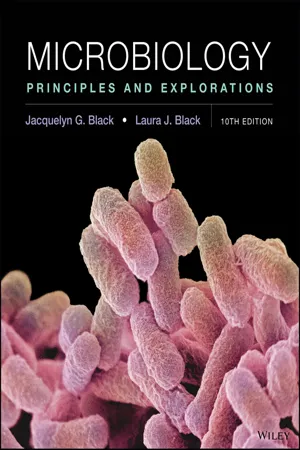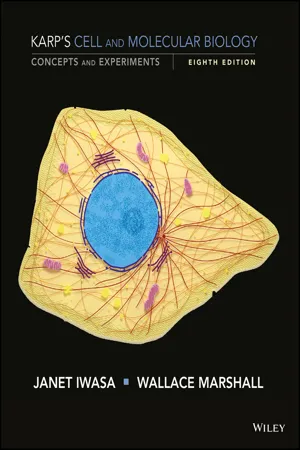Biological Sciences
Eukaryotic Cells
Eukaryotic cells are complex, containing a defined nucleus and other membrane-bound organelles. These cells are found in plants, animals, fungi, and protists. Eukaryotic cells are characterized by their ability to carry out specialized functions due to the compartmentalization provided by their organelles.
Written by Perlego with AI-assistance
Related key terms
1 of 5
12 Key excerpts on "Eukaryotic Cells"
- eBook - PDF
- Nina Parker, Mark Schneegurt, Anh-Hue Thi Tu, Brian M. Forster, Philip Lister(Authors)
- 2016(Publication Date)
- Openstax(Publisher)
Some Eukaryotic Cells are independent, single-celled microorganisms, whereas others are part of multicellular organisms. The cells of eukaryotic organisms have several distinguishing characteristics. Above all, Eukaryotic Cells are defined by the presence of a nucleus surrounded by a complex nuclear membrane. Also, Eukaryotic Cells are characterized by the presence of membrane- bound organelles in the cytoplasm. Organelles such as mitochondria, the endoplasmic reticulum (ER), Golgi apparatus, lysosomes, and peroxisomes are held in place by the cytoskeleton, an internal network that supports 122 Chapter 3 | The Cell This OpenStax book is available for free at http://cnx.org/content/col12087/1.4 transport of intracellular components and helps maintain cell shape (Figure 3.35). The genome of Eukaryotic Cells is packaged in multiple, rod-shaped chromosomes as opposed to the single, circular-shaped chromosome that characterizes most prokaryotic cells. Table 3.2 compares the characteristics of eukaryotic cell structures with those of bacteria and archaea. Figure 3.35 An illustration of a generalized, single-celled eukaryotic organism. Note that cells of eukaryotic organisms vary greatly in terms of structure and function, and a particular cell may not have all of the structures shown here. Summary of Cell Structures Prokaryotes Cell Structure Bacteria Archaea Eukaryotes Size ~0.5–1 μM ~0.5–1 μM ~5–20 μM Surface area-to- volume ratio High High Low Nucleus No No Yes Table 3.2 Chapter 3 | The Cell 123 - eBook - ePub
- Patricia Barnes-Svarney, Thomas E. Svarney(Authors)
- 2014(Publication Date)
- Visible Ink Press(Publisher)
eucariotique (French for prokaryotic and eukaryotic, respectively). Prokaryotic, meaning “before nucleus,” was used to describe bacteria, while eukaryotic, meaning “true nucleus,” was used to describe all other cells. Today, the terms are more well defined: Eukaryotic Cells are much more complex than prokaryotic cells, having compartmentalized interiors and membrane-contained organelles (small structures within cells that perform dedicated functions; for more about organelles, see this chapter) within their cytoplasm. The major feature of a eukaryotic cell is its membrane-bound nucleus—the active part of the cell that contains genetic information; prokaryotic cells do not have a nuclear membrane (the membrane that surrounds the nucleus of the cell).The cells also differ in size: Eukaryotic Cells are generally much larger and more complex than prokaryotic cells. In fact, most Eukaryotic Cells are one hundred to 1,000 times the volume of typical prokaryotic cells. The following lists the general differences between these cells (for more about the characteristics of cells, see this chapter):Comparison of Prokaryotic and Eukaryotic Cells
Plant and animal cells share some attribues, such as cell walls, nuclei, and mitochondria, but they also have differences, such as the chloroplasts that only exist in plant cells.Characteristic Prokaryotic Cells Eukaryotic Cells Organisms Eubacteria and Archaebacteria Protista, Fungi, Plantae, Animalia Cell size Usually 1–10 MGRm across Usually 10–100 MGRm across Membrane-bound organelles No Yes Ribosomes Yes, very small Yes, larger Type of cell division Cell fission Mitosis and meiosis DNA location Nucleoid Nucleus Membranes No internal Many Cytoskeleton No Yes Metabolism Anaerobic or aerobic Aerobic How big are animal cells?
Most animal cells are very small, and most cannot be seen without a microscope; in fact, most cells are smaller than the period at the end of this sentence. Two exceptions are bird and frog egg cells—both are larger cells readily observable with the unaided eye. For example, the chicken egg is actually one single cell—the nucleus, cytoplasm, and cellular membrane, which contains an abundance of yolk and albumin—the nutrients needed for the developing chick (embryo)—making this cell much larger than the normally functioning cells within the chicken. - eBook - PDF
- Rodney P. Anderson, Linda Young, Kim R. Finer(Authors)
- 2020(Publication Date)
- Wiley(Publisher)
Given that fact, what can you conclude about the origins of these different groups? Summary 6.1 An Introduction to Eukaryotic Cells 123 • Eukaryotic Cells are distinguished by the presence of organ- elles, or structures that carry out coordinated specialized functions. The most prominent organelle is the nucleus, the structure that gives the cell type its name. • Eukaryotic Cells are 10–100 times larger than prokaryotic cells. The upper limit of eukaryotic cell size is determined by the abil- ity of the plasma membrane to transport adequate nutrients to fulfill the nutritional requirements of the cell. This is a challenge because cell volume increases faster than surface area, limiting the size of most Eukaryotic Cells. • Through cellular differentiation, Eukaryotic Cells may pro- duce multicellular organisms with functionally distinctive cell types. Multicellularity provides a longer life span and a compet- itive size advantage. 6.2 The Plasma Membrane and Cell Wall 124 • Plasma membranes of Eukaryotic Cells are similar in structure and function to prokaryotic plasma membranes. These phos- pholipid bilayers provide selective permeability for the cell. Animal, plant, and fungal plasma membranes contain sterols that provide additional membrane strength and stability. Some eukaryotic plasma membranes also have an attached glycoc- alyx. Organelle membranes are similar to plasma membranes but contain a variety of proteins and pores specific to organelle function. • Specialized processes allow compounds and particles to exit (through exocytosis) or enter (through endocytosis) eukary- otic cells. In either process, the plasma membrane or organelle membrane engulfs targets into vesicles, which then transport or destroy contents as needed. The ingestion of solid particles into Key Terms 141 6.4 External Structures and Other Cellular Forms 134 • Control of material flow and communication between adjacent cells (paracellular transport) is important in multicellular organisms. - eBook - PDF
Microbiology
Principles and Explorations
- Jacquelyn G. Black, Laura J. Black(Authors)
- 2018(Publication Date)
- Wiley(Publisher)
(Courtesy Richard Blakemore, University of New Hampshire) (a) (b) Eukaryotic Cells 97 Eukaryotic Cells An Overview of Structure Eukaryotic Cells are larger and more complex than pro- karyotic cells. Most Eukaryotic Cells have a diameter of more than 10 μm, and many are much larger. They also contain a variety of highly differentiated structures. These cells are the basic structural unit of all organisms in the kingdoms Protista, Plantae, Fungi, and Animalia ( ▶ Chapter 10).Eukaryotic organisms include microscopic protozoa, algae, and fungi and are thus appropriately considered in microbiology. The general structure of the eukaryotic cell is shown diagrammatically in Figure 5.18. FIGURE 5.18 A generalized eukaryotic cell. Most of the features shown are present in nearly all Eukaryotic Cells, but some (the centrioles, microvilli, and lysosomes) occur only in animal cells, and others (the chloroplast) are found only in cells capable of carrying out photosynthesis. SEM FIGURE 5.17 The slime layer. Bacteria growing on tooth enamel, to which they initially adhere by means of their slime layer (9,088X). This constitutes a “biofilm,” and protects the bacteria at the bottom of the layer from toothpaste and mouthwashes. (Dr. Tony Brain/Science Source). Secretory vesicle Centrosome: Centrioles Microtubule Microfilament Smooth endoplasmic reticulum Rough endoplasmic reticulum CYTOPLASM (cytosol plus organelles except the nucleus) Pericentriolar material Cilium Golgi complex Microfilament Chloroplast Ribosome PLASMA MEMBRANE NUCLEUS: Glycogen granules Nucleolus Chromatin Nuclear envelope Mitochondrion Microtubule Peroxisome Lysosome Cytoskeleton: Intermediate filament Microvilli 1. How do bacteria move in chemotaxis? Distinguish between runs and tumbles, and their frequencies. 2. What risk would a spore-forming bacterial species run if it did not produce any spores until conditions became adverse? 3. What are the functions of pili? 4. Distinguish between nucleus and nucleoid. - eBook - PDF
- Gerald Karp, Janet Iwasa, Wallace Marshall(Authors)
- 2021(Publication Date)
- Wiley(Publisher)
The cytoplasm of a eukaryotic cell is filled with a great diversity of structures, as is readily apparent by examining an electron micrograph of nearly any plant or animal cell (Figure 1.10). Even yeast, the simplest eukaryote, is much more com- plex structurally than an average bacterium, even though these two organisms have a similar number of genes. Eukaryotic Cells TABLE 1.1 A Comparison of Prokaryotic and Eukaryotic Cells Features held in common by the two types of cells: • Plasma membrane of similar construction • Genetic information encoded in DNA using identical genetic code • Similar mechanisms for transcription and translation of genetic information, including similar ribosomes • Shared metabolic pathways (e.g., glycolysis and TCA cycle) • Similar apparatus for conservation of chemical energy as ATP (located in the plasma membrane of prokaryotes and the mitochondrial membrane of eukaryotes) • Similar mechanism of photosynthesis (between cyanobacteria and green plants) • Similar mechanism for synthesizing and inserting membrane proteins • Proteasomes (protein-digesting structures) of similar construction (between archaebacteria and eukaryotes) • Cytoskeletal filaments built of proteins similar to actin and tubulin Features of Eukaryotic Cells not found in prokaryotes: • Division of cells into nucleus and cytoplasm, separated by a nuclear envelope containing complex pore structures • Complex chromosomes composed of DNA and associated proteins that are capable of compacting into mitotic structures • Complex membranous cytoplasmic organelles (includes endoplasmic reticulum, Golgi complex, lysosomes, endosomes, peroxisomes, and glyoxisomes) • Specialized cytoplasmic organelles for aerobic respiration (mitochondria) and photosynthesis (chloroplasts) • Complex cytoskeletal system (including actin filaments, intermediate filaments, and microtubules) and associated motor proteins • Complex flagella and cilia • Ability to ingest particulate material by enclosure within plasma membrane vesicles (phagocytosis) • Cellulose-containing cell walls (in plants) • Cell division using a microtubule-containing mitotic spindle that separates chromosomes • Presence of two copies of genes per cell (diploidy), one from each - eBook - PDF
- Gerald Karp, Janet Iwasa, Wallace Marshall(Authors)
- 2018(Publication Date)
- Wiley(Publisher)
In contrast, nearly all prokaryotes that have been studied contain a single, circular chromosome. More impor- tantly, the chromosomal DNA of eukaryotes, unlike that of prokaryotes, is tightly associated with proteins to form a complex nucleoprotein material known as chromatin. The cytoplasm of the two types of cells is also very different. The cytoplasm of a eukaryotic cell is filled with a great diversity of structures, as is readily apparent by examining an electron micro- graph of nearly any plant or animal cell (FIGURE 1.10). Even yeast, the simplest eukaryote, is much more complex structurally than an average bacterium, even though these two organisms have a similar number of genes. Eukaryotic Cells contain an array of membrane-bound organelles. Eukaryotic organelles include mitochondria, where chemical energy is made available to fuel cellular activities; an endoplasmic reticulum, where many of a cell’s proteins and lipids are manufactured; Golgi complexes, where materials are sorted, modified, and transported to specific cellular destinations; and a variety of simple membrane-bound vesicles of varying dimension. Plant cells contain additional membranous organelles, including chloroplasts, which are the sites of photosynthesis, and often a single large vacuole that can occupy most of the volume of the cell. Taken as a group, the membranes of the eukaryotic cell serve to divide the cytoplasm into compartments within which specialized activities can take place. In contrast, the cytoplasm of prokaryotic cells is essentially devoid of membranous structures. The complex photosynthetic membranes of the cyanobacteria are a major exception to this generalization (see Figure 1.15). The cytoplasmic membranes of Eukaryotic Cells form a sys- tem of interconnecting channels and vesicles that function in the transport of substances from one part of a cell to another, as well as between the inside of the cell and its environment. - eBook - PDF
Karp's Cell and Molecular Biology
Concepts and Experiments
- Gerald Karp, Janet Iwasa, Wallace Marshall(Authors)
- 2016(Publication Date)
- Wiley(Publisher)
Internally, Eukaryotic Cells are much more complex—both structurally and functionally—than prokaryotic cells (Figure 1.8). Photosynthetic bacteria ? Cyanobacteria Eukaryotes Algal kingdoms Shelly invertebrates Vascular plants Mammals Humans Origin of Earth Billions of years ago Precambrian 2 3 4 1 Life Cenozoic Mesozoic Paleozoic FIGURE 1.9 Earth’s biogeologic clock. A portrait of the past five billion years of Earth’s history showing a proposed time of appearance of major groups of organisms. Complex animals (shelly invertebrates) and vascular plants are relatively recent arrivals. The time indicated for the origin of life is speculative. In addition, photosynthetic bacteria may have arisen much earlier, hence the question mark. The geologic eras are indicated in the center of the illustration. SOURCE: From D. J. Des Marais, Science 289:1704, 2001. Copyright © 2001. Reprinted with permission from AAAS. CHAPTER 1 Introduction to the Study of Cell and Molecular Biology 10 2 Eight million base pairs is equivalent to a DNA molecule nearly 3 mm long. The difference in structural complexity is evident in the electron micrographs of a bacterial and an animal cell shown in Figures 1.18 a and 1.10, respectively. Both contain a nuclear region that houses the cell’s genetic material, surrounded by cytoplasm. The genetic mate- rial of a prokaryotic cell is present in a nucleoid: a poorly demar- cated region of the cell that lacks a boundary membrane to separate it from the surrounding cytoplasm. In contrast, Eukaryotic Cells pos- sess a nucleus: a region bounded by a complex membranous struc- ture called the nuclear envelope. This difference in nuclear structure is the basis for the terms prokaryotic ( pro = before, karyon = nucleus) and eukaryotic ( eu = true, karyon = nucleus). - eBook - PDF
- Jan Koolman, Klaus-Heinrich Röhm(Authors)
- 2012(Publication Date)
- Thieme(Publisher)
Cell Organelles Basics Basics 194 Structure of Cells The cell is the basic unit of organisms. A. Comparison of prokaryotes and eukaryotes Present-day living organisms can be divided into two large groups—the prokaryotes and eukaryotes. The prokaryotes are represented by bacteria (eubacteria and archaea). These are almost all small unicellular organisms only a few micrometers (1 micrometer = 10 –6 m) in size. The eukaryotes include fungi , plants , and animals and comprise both unicellular and multicellular organisms. Multicellular eukary-otes are made up of a wide variety of cell types that are specialized for different tasks. The cells of eukaryotes are much larger than those of prokaryotes (volume ratio ~2000 : 1). The most important distinguishing feature of these cells compared to those of prokaryotes is that they have a nucleus . Compared to the prokaryotes, Eukaryotic Cells have greater specialization and complexity in their structure and functioning. Eukaryotic Cells are structured into compartments (see be-low). The metabolism and synthesis of macro-molecules are distributed through these reac-tion spaces and are separately regulated. In prokaryotes, by contrast, these functions are organized in a simpler fashion and are spatially closely related. Although the storage and transfer of genetic information function according to the same principles in the prokaryotes and eukaryotes, there are also differences. Eukaryotic DNA con -sists of very long, linear molecules with a total of 10 7 to more than 10 10 base pairs (bp), only a small fraction of which are used for genetic in-formation. In eukaryotes, the genes (20 000– 50 000 per genome) are usually interrupted by noncoding regions ( introns ). Eukaryotic DNA is located in the nucleus, where together with histones and other proteins it forms the chro-matin (p. 234). In prokaryotes, DNA is ring-shaped, much shorter (up to 6 × 10 6 bp), and located in the cytoplasm. - eBook - PDF
- Cecie Starr, Beverly McMillan(Authors)
- 2015(Publication Date)
- Cengage Learning EMEA(Publisher)
It consists of a thick, jellylike fluid called the cytosol , and various other components. There are two basic kinds of cells Cells are classified into two basic kinds, depending on how they are organized internally (Table 3.1). In a prokaryotic cell (pro-care-ee-ah-tik, meaning “before the nucleus”) nothing separates the cell’s DNA from other internal cell parts. Bacteria, like the one diagrammed in Figure 3.1A, are prokaryotic cells. Cells that have their DNA inside a nucleus are called Eukaryotic Cells (yew-car e-ee-ah-tik, “true nucleus”). The nucleus is one of numerous organelles (“little organs”) in Eukaryotic Cells (Figure 3.1B). Organelles are compartments or sacs. We will discuss them more fully in Section 3.2. Most cells have a large surface area compared to their volume A few cells—including the yolks of chicken eggs—can be seen with the unaided eye, but most cells are so small that they can only be seen with a microscope. For instance, a Figure 3.1 Animated! There are two basic types of cells. A A prokaryotic cell. B A eukaryotic cell, which has many types of organelles, including a nucleus. Figure 3.2 The relationship of surface to volume influences the size of cells. Here boxes represent cells. If the linear dimensions of a box double, the volume increases 8 times but the surface area increases only 4 times. As in the text example, if the linear dimensions increase by 4 times, the volume is 64 times greater but the surface area is only 16 times larger. A Bacterial cell (prokaryotic) B Animal cell (eukaryotic) Manfred Cage/Peter Arnold, Inc. 3.1 © Cengage Learning Eukaryotic Prokaryotic Plasma membrane yes yes Region that contains DNA yes yes Cytoplasm yes yes Nucleus inside a membrane yes no TABLE 3.1 Eukaryotic and Prokaryotic Cells Compared 1 cube 2 cube 4 cube 1 8 64 V olume: Surface area: 6 24 96 Linear dimension: © Cengage Learning Copyright 2016 Cengage Learning. - eBook - PDF
- Mary Ann Clark, Jung Choi, Matthew Douglas(Authors)
- 2018(Publication Date)
- Openstax(Publisher)
Unlike prokaryotic cells, Eukaryotic Cells have: 1) a membrane-bound nucleus; 2) numerous membrane-bound organelles such as the endoplasmic reticulum, Golgi apparatus, chloroplasts, mitochondria, and others; and 3) several, rod-shaped chromosomes. Because a membrane surrounds eukaryotic cell’s nucleus, it has a “true nucleus.” The word “organelle” means “little organ,” and, as we already mentioned, organelles have specialized cellular functions, just as your body's organs have specialized functions. At this point, it should be clear to you that Eukaryotic Cells have a more complex structure than prokaryotic cells. Organelles allow different functions to be compartmentalized in different areas of the cell. Before turning to organelles, let’s first examine two important components of the cell: the plasma membrane and the cytoplasm. Chapter 4 | Cell Structure 113 (a) (b) Figure 4.8 These figures show the major organelles and other cell components of (a) a typical animal cell and (b) a typical eukaryotic plant cell. The plant cell has a cell wall, chloroplasts, plastids, and a central vacuole—structures not in animal cells. Most cells do not have lysosomes or centrosomes. 114 Chapter 4 | Cell Structure This OpenStax book is available for free at http://cnx.org/content/col24361/1.8 If the nucleolus were not able to carry out its function, what other cellular organelles would be affected? The Plasma Membrane Like prokaryotes, Eukaryotic Cells have a plasma membrane (Figure 4.9), a phospholipid bilayer with embedded proteins that separates the internal contents of the cell from its surrounding environment. A phospholipid is a lipid molecule with two fatty acid chains and a phosphate-containing group. The plasma membrane controls the passage of organic molecules, ions, water, and oxygen into and out of the cell. Wastes (such as carbon dioxide and ammonia) also leave the cell by passing through the plasma membrane. - eBook - PDF
- Julianne Zedalis, John Eggebrecht(Authors)
- 2018(Publication Date)
- Openstax(Publisher)
Cells fall into one of two broad categories: prokaryotic and eukaryotic. Only the predominantly single-celled organisms of the domains Bacteria and Archaea are classified as prokaryotes (pro- = “before”; -kary- = “nucleus”). Cells of animals, plants, fungi, and protists are all eukaryotes (eu- = “true”) and have a nucleus. Components of Prokaryotic Cells All cells share four common components: 1) a plasma membrane, an outer covering that separates the cell’s interior from its surrounding environment; 2) cytoplasm, consisting of a jelly-like cytosol within the cell in which other cellular components are found; 3) DNA, the genetic material of the cell; and 4) ribosomes, which synthesize proteins. However, prokaryotes differ from Eukaryotic Cells in several ways. A prokaryote is a simple, single-celled (unicellular) organism that lacks a nucleus, or any other membrane-bound organelle. We will shortly come to see that this is significantly different in eukaryotes. Prokaryotic DNA is found in a central part of the cell: the nucleoid (Figure 4.5). 152 Chapter 4 | Cell Structure This OpenStax book is available for free at http://cnx.org/content/col12078/1.6 Figure 4.5 This figure shows the generalized structure of a prokaryotic cell. All prokaryotes have chromosomal DNA localized in a nucleoid, ribosomes, a cell membrane, and a cell wall. The other structures shown are present in some, but not all, bacteria. While the Earth is approximately 4.6 billion years old, the earliest fossil evidence for life are of microbial mats that date back to 3.5 billion years. What type of evidence for life was most likely found in a 3.5 billion year old rock? a. Scientists found bones buried in the rock that resemble bones of living animals. b. Dead cells buried in the rock superficially resemble living prokaryotic cells. c. The fossil superficially resembles living microbial mats that exist today. - eBook - PDF
- Joyce James, Colin Baker, Helen Swain(Authors)
- 2008(Publication Date)
- Wiley-Blackwell(Publisher)
Chapter Five CELLS smaller cells have their DNA free in the cell cyto-plasm. Despite these differences, we can think of both human and bacterial cells as genetic material surrounded by cytoplasm which is enclosed by a thin membrane (Fig. 5.1). Eukaryotic Cells interact with each other All complex organisms are made from cells in much the same way as a house is built from bricks. The cells are organised and interact to perform different functions; those that carry out the same function are grouped together to form a tissue, e.g. liver tissue is made from liver cells. Different tissues are grouped together to form organs, e.g. the heart is made from muscle and nervous tissue which work together so that the heart pumps blood round the body. For activities carried out by the body, organs are grouped in systems. Urine production and excretion involves the kidneys, ureters, bladder and urethra, collectively called the urinary or excretory system. The organ systems are pack-aged together to form multicellular organisms, e.g. humans, animals, plants and fungi. It is amazing that such complexity can be derived from a single basic structure. Introduction Cells are the basic unit of life and yet they cannot be seen easily without a microscope because they are so small (human cells are about 25 micrometres ( m m) wide). As a nurse, you could be taking samples of cells, e.g. blood, biopsies, throat swabs from patients for analysis in the laboratory. The tests might be simply counting and sorting the cells into different types but this can tell us a lot about the well-being of a patient and how to treat them, e.g. a low red blood cell count could indicate anaemia. The human body contains 60 billion (6 ¥ 10 13 ) cells and about two hundred different cell types; fortunately they all share the same basic structure. Two cell types There are two main types of cells – Eukaryotic Cells(animal,plantand fungi) and prokaryotic cells (bacteria).
Index pages curate the most relevant extracts from our library of academic textbooks. They’ve been created using an in-house natural language model (NLM), each adding context and meaning to key research topics.











